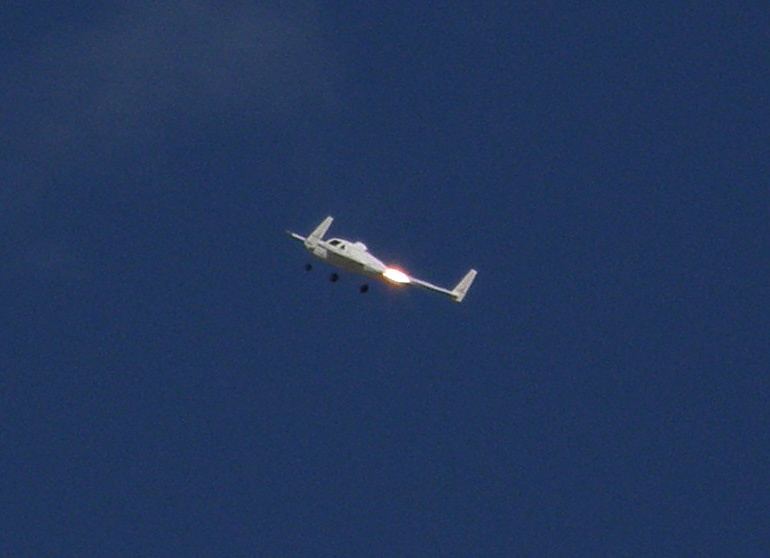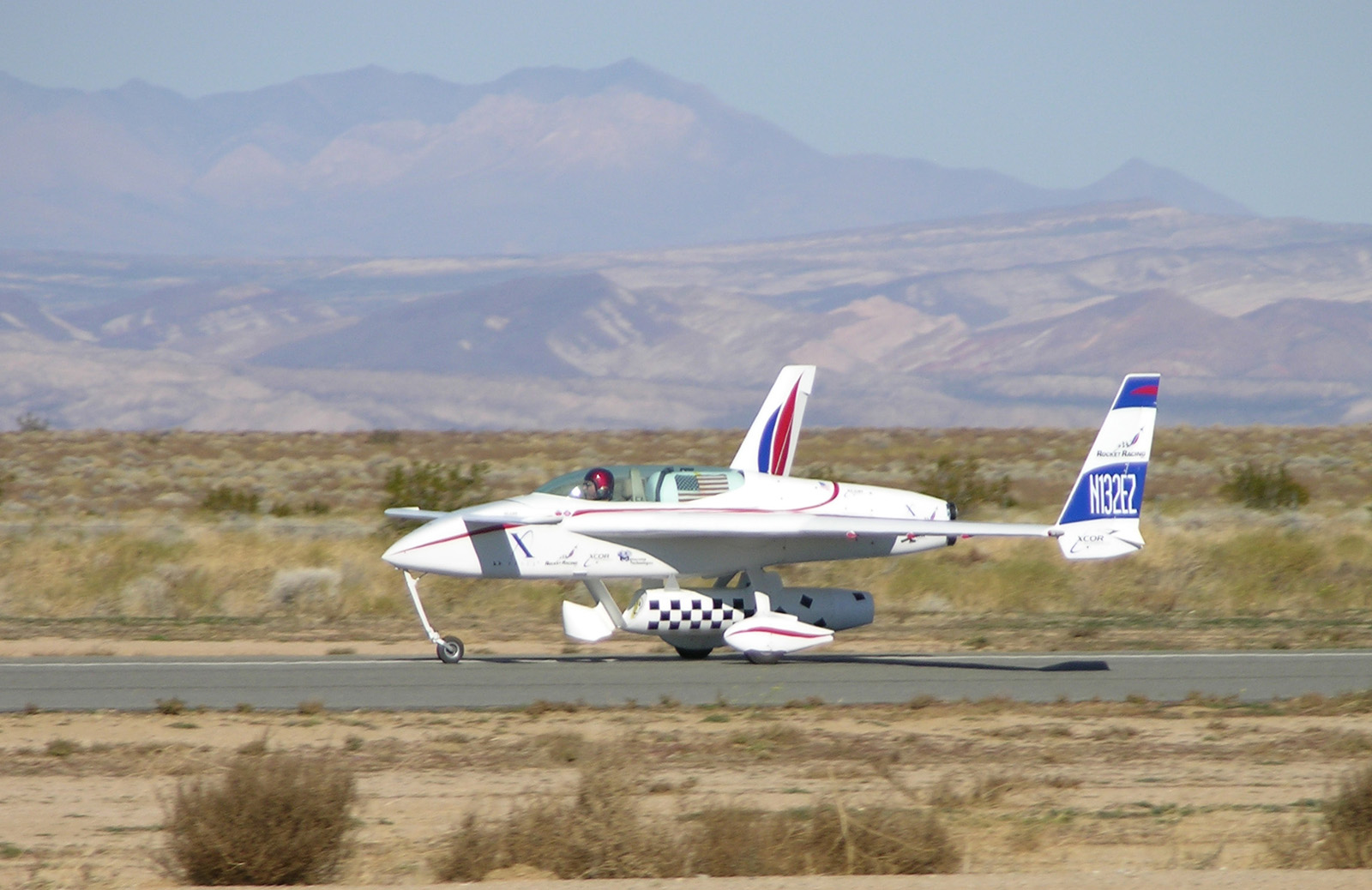|
Rutan Long-EZ
The Rutan Model 61 Long-EZ is a tandem 2-seater homebuilt aircraft designed by Burt Rutan's Scaled Composites. The Long-EZ has a canard layout, a swept wing with wingtip rudders, and a pusher engine and propeller. The tricycle landing gear has fixed main wheels with streamlined spats and a retractable nosewheel. Its predecessor was the VariEze, plans for which were first available to homebuilders in 1976. The prototype Long-EZ, N79RA, first flew on June 12, 1979. Design The Long-EZ was a scaled-up redesign of the VariEze predecessor, allowing for the use of readily available Lycoming aircraft engines instead of the Volkswagen-derived engines or hard-to-find small Continentals for which the VariEze was designed. Changes from the VariEze included a larger main wing with modified Eppler 1230 airfoil and less sweep, larger strakes containing more fuel and baggage storage, and a slightly wider cabin. The canard uses the same GU25-5(11)8 airfoil as the VariEze. Plans were offer ... [...More Info...] [...Related Items...] OR: [Wikipedia] [Google] [Baidu] |
NOAA
The National Oceanic and Atmospheric Administration (NOAA ) is an American scientific and regulatory agency charged with forecasting weather, monitoring oceanic and atmospheric conditions, charting the seas, conducting deep-sea exploration, and managing fishing and protection of marine mammals and endangered species in the US exclusive economic zone. The agency is part of the United States Department of Commerce and is headquartered in Silver Spring, Maryland. History NOAA traces its history back to multiple agencies, some of which are among the earliest in the federal government: * United States Coast and Geodetic Survey, formed in 1807 * Weather Bureau of the United States, formed in 1870 * Bureau of Commercial Fisheries, formed in 1871 (research fleet only) * Coast and Geodetic Survey Corps, formed in 1917 The most direct predecessor of NOAA was the Environmental Science Services Administration (ESSA), into which several existing scientific agencies such as the ... [...More Info...] [...Related Items...] OR: [Wikipedia] [Google] [Baidu] |
Side-stick
A side-stick or sidestick controller is an aircraft control stick that is located on the side console of the pilot, usually on the righthand side, or outboard on a two-seat flightdeck. Typically this is found in aircraft that are equipped with fly-by-wire control systems.Crane, Dale: ''Dictionary of Aeronautical Terms, third edition'', page 463. Aviation Supplies & Academics, 1997. The throttle controls are typically located to the left of a single pilot or centrally on a two-seat flightdeck. Only one hand is required to operate them; two handed operation is neither possible nor necessary. Prevalence The side-stick is used in many modern military fighter aircraft, such as the F-16 Fighting Falcon, Mitsubishi F-2, Dassault Rafale, and F-22 Raptor, F-35 Lightning 2, Chengdu J-20, AIDC F-CK 1 Ching-Kuo and also on civil aircraft, such as the Sukhoi Superjet 100, Airbus A320 and all subsequent Airbus aircraft, including the largest passenger jet in service, the Airbus A38 ... [...More Info...] [...Related Items...] OR: [Wikipedia] [Google] [Baidu] |
Norton NR642
The Norton NR642 (Originally the Aerotor 90) is a British aircraft engine that was designed and produced by Norton Motorcycle Company in the 1990s for use in light aircraft (particularly by amateur constructors) and UAVs.Lambert 1991, p.709 Design and development The NR642 is a twin-rotor Wankel engine. It is a displacementMoll 1989, p.20 petrol engine design, with a heavy-duty 2.94:1 reduction gearbox. Cooling is provided by a fan for the rotors, plus liquid cooling for the housing. It was designed to meet JAR-E and FAR 23 regulatory requirements. Norton aimed for 1,500 hours running time between overhauls but was initially specifying 200-300 hours. The NR642 first flew in late 1989, with two units installed on a Rutan Long-EZ to create what its builder called a "Twin EZ"."Rotary Power by Norton Motors", p.20 Applications *Aircorp Bushmaster *Rutan Long-EZ The Rutan Model 61 Long-EZ is a tandem 2-seater homebuilt aircraft designed by Burt Rutan's Scaled Composites. ... [...More Info...] [...Related Items...] OR: [Wikipedia] [Google] [Baidu] |
Universe Today
Universe Today (U.T.) is a North American-based non-commercial space and astronomy news website founded by Fraser Cain. The domain was registered on December 30, 1998, and the website went live in March 1999. ''Universe Today'' assumed its current form on July 24, 2003, featuring astronomy news and other space-related content. In early September 2005, the website’s forum section merged with '' Bad Astronomy'' to create a combined site with the BAUT forum. During April 2011, the Association of British Science Writers noted that ''Universe Today'' decided not to make preparations for reporting on embargoed stories until they are public knowledge. Emily Lakdawalla said that she relies on ''Universe Today'' and '' Bad Astronomy'' to "give ... an independent look at big news stories". Publications ''Universe Today'' has published two books, which are available both as e-books and on physical media: * * See also * '' Astronomy Cast'' * ''Space.com Space.com is an on ... [...More Info...] [...Related Items...] OR: [Wikipedia] [Google] [Baidu] |
Velocity SE
The Velocity Model 173 SE (Standard Elite) is an entry-level canard (aeronautics), canard Pusher configuration, pusher aircraft from Velocity Aircraft.Velocity SE , Velocity Aircraft website, 2008, accessed 2010-12-11.Vandermeullen, Richard: ''2011 Kit Aircraft Buyer's Guide'', Kitplanes, Volume 28, Number 12, December 2011, page 75. Belvoir Publications. The four seat, rear engine aircraft may be powered by a Lycoming IO-320 or a Lycoming IO-360 engine. Variants ;Velocity SE-FG :Fixed landing gear version, 88 completed and flown by December 2011. ;Velocity SE-RG :Retractable landing gear version, 180 completed and flown by December 2011. ; Rocket Racer : The Rocket Racing ...[...More Info...] [...Related Items...] OR: [Wikipedia] [Google] [Baidu] |
Rocket Racing League
The Rocket Racing League was a racing league that planned to use rocket-powered aircraft to race a closed-circuit air racetrack. Founded in 2005, the league made its first public flights in 2010 and was working to begin regular racing seasons. The "Rocket Racers" were slated to compete in the air and on a virtual racetrack easily viewed by a live audience as well as projected on large screen and handheld electronic displays. Three prototype canard-style ''Rocket Racer'' aircraft were built between 2006 and 2010. The league had planned to hold its inaugural race season in 2008 with four races, but encountered financial difficulties that delayed fielding of ''Rocket Racers'' by the six teams that had been previously announced. With the addition of venture capital funding in mid-2009, technology development continued and one exhibition occurred in 2010, with another round of plans for an inaugural season of races in 2011. The 2011 races were never scheduled and the league was def ... [...More Info...] [...Related Items...] OR: [Wikipedia] [Google] [Baidu] |
XCOR Aerospace
XCOR Aerospace was an American private spaceflight and rocket engine development company based at the Mojave Air and Space Port in Mojave, California, Midland International Air and Spaceport in Midland, Texas and the Amsterdam area, the Netherlands. XCOR was formed in 1999 by former members of the Rotary Rocket rocket engine development team, and ceased operations in 2017. By 2015, XCOR was headed by CEO John "Jay" Gibson, who remained CEO until June 2017. XCOR Aerospace was the parent operation, concerned with engineering and building spaceships and had two main subdivisions within it; XCOR Space Expeditions provided marketing and sales, and XCOR Science had been set up to conduct scientific and educational payload flights. By May 2016, XCOR was laying off staff and in 2017, XCOR closed their doors for good and filed for Chapter 7 bankruptcy. History The company was founded in Mojave, California in 1999 by Jeff Greason, Dan DeLong, Aleta Jackson and Doug Jones who had ... [...More Info...] [...Related Items...] OR: [Wikipedia] [Google] [Baidu] |
XCOR EZ-Rocket
The XCOR EZ-Rocket was a test platform for the XCOR XR-4A3 rocket propulsion system. The airplane was a modified Rutan Long-EZ, with the propeller replaced by first one, then later a pair of pressure-fed regeneratively cooled liquid-fueled rocket engines and an underslung fuel tank. The engines were restartable in flight, and were contained within Kevlar armor shielding. The EZ-Rocket was registered as an experimental aircraft. Development and history The first flight took place on July 21, 2001, flown by test pilot Dick Rutan. On a typical flight, the EZ-Rocket took off on rockets, gained altitude for a minute or so, then switched off the rockets and glided to a dead stick landing. The vehicle actually flew better during dead stick landings than a standard Long-EZ due to lack of drag from a stationary pusher propeller — the vehicle's aerodynamics were cleaner in spite of its belly tank. It was also lighter due to the lack of a piston engine (the rocket propulsion s ... [...More Info...] [...Related Items...] OR: [Wikipedia] [Google] [Baidu] |
Experimental Aircraft Association
The Experimental Aircraft Association (EAA) is an international organization of aviation enthusiasts based in Oshkosh, Wisconsin. Since its inception, it has grown internationally with over 300,000 members and nearly 1,000 chapters worldwide. It hosts the largest aviation gathering of its kind in the world, EAA AirVenture Oshkosh. History The EAA was founded in 1953 by veteran aviator Paul Poberezny along with other aviation enthusiasts. The organization began as more or less a flying club. Poberezny explains the nature of the organization's name, "Because the planes we flew were modified or built from scratch, they were required to display an EXPERIMENTAL placard where it could be seen on the door or cockpit, so it was quite natural that we call ourselves the "Experimental Aircraft Association". The EAA was incorporated in Wisconsin on 22 March 1955. Homebuilt aircraft, Homebuilding is still a large part of EAA, but the organization has grown over the years to include almost ... [...More Info...] [...Related Items...] OR: [Wikipedia] [Google] [Baidu] |
Mike Melvill
Michael Winston Melvill (born November 30, 1940, in Johannesburg, South Africa) is a world-record-breaking pilot and one of the test pilots for SpaceShipOne, the experimental spaceplane developed by Scaled Composites. Melvill piloted SpaceShipOne on its first flight past the edge of space, SpaceShipOne flight 15P, flight 15P on June 21, 2004, thus becoming the first commercial astronaut, and the 435th person to go into space. He was also the pilot on SpaceShipOne's SpaceShipOne flight 16P, flight 16P, the first competitive flight in the Ansari X Prize competition. Life and career In 1978, Melvill met aerospace designer and Scaled Composites founder Burt Rutan when he flew to California to show Rutan the Rutan VariViggen, VariViggen he had built at his home. Rutan then hired him on the spot. In 1982, he was named Rutan's lead test pilot. In 1997, Melvill and Dick Rutan, Burt's brother, flew two Rutan Long-EZ, Long-Eze aircraft that they built side-by-side around the world. T ... [...More Info...] [...Related Items...] OR: [Wikipedia] [Google] [Baidu] |
Dick Rutan
Richard Glenn Rutan (July 1, 1938 – May 3, 2024) was an American military aviator and officer, as well as a record-breaking test pilot who in 1986 piloted the Voyager aircraft on the first non-stop, non-refueled around-the-world flight with co-pilot Jeana Yeager. He was the older brother of famed aerospace designer Burt Rutan, whose many earlier original designs Dick piloted on class record-breaking flights, including Voyager. Life and career Rutan was born and raised in Loma Linda, California, where he gained an interest in aviation at a young age. He learned to fly at age 15, taking his first solo flight on his 16th birthday, and later attended Reedley Junior College while waiting to report for the military. At Reedley College, he worked with aircraft engines toward getting an official FAA power plant license (also referred to as an Aviation Maintenance Technician). Through his interest in piloting, he went on to earn commercial, instrument, multiengine, seaplane a ... [...More Info...] [...Related Items...] OR: [Wikipedia] [Google] [Baidu] |







